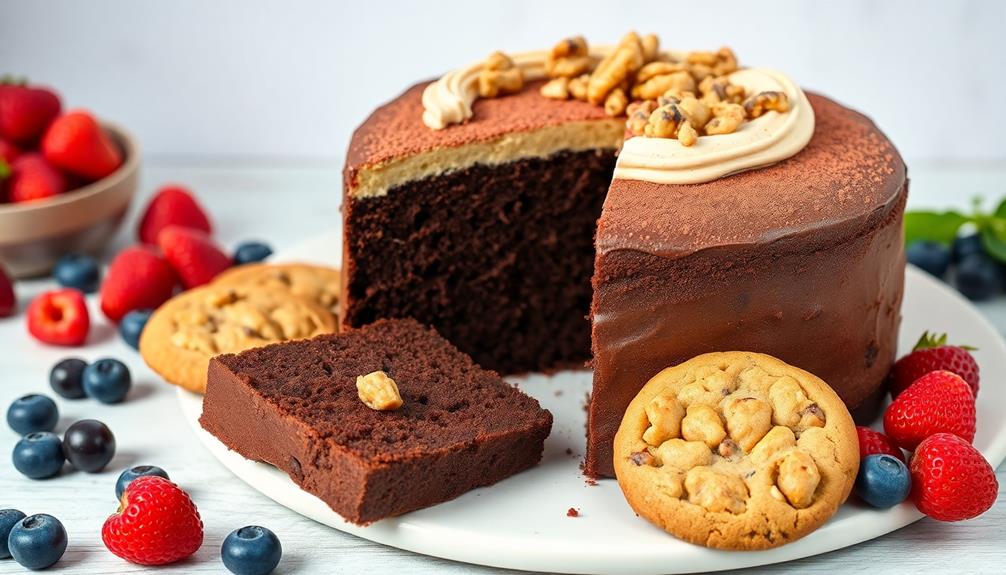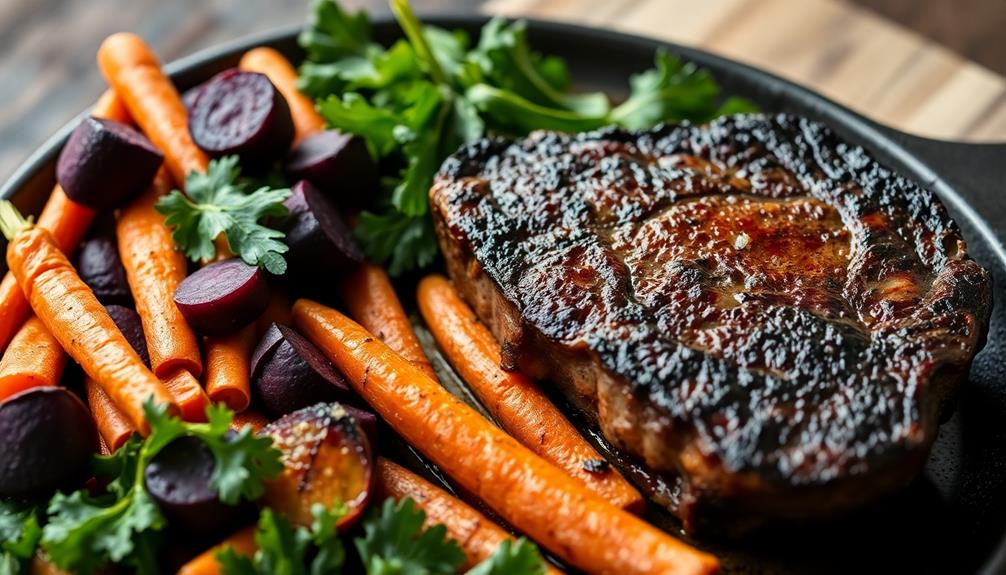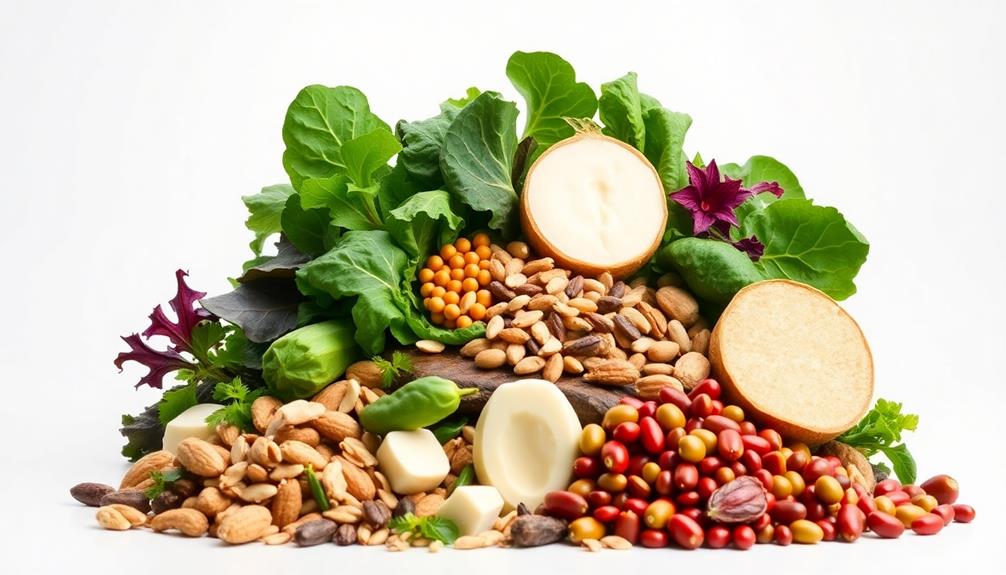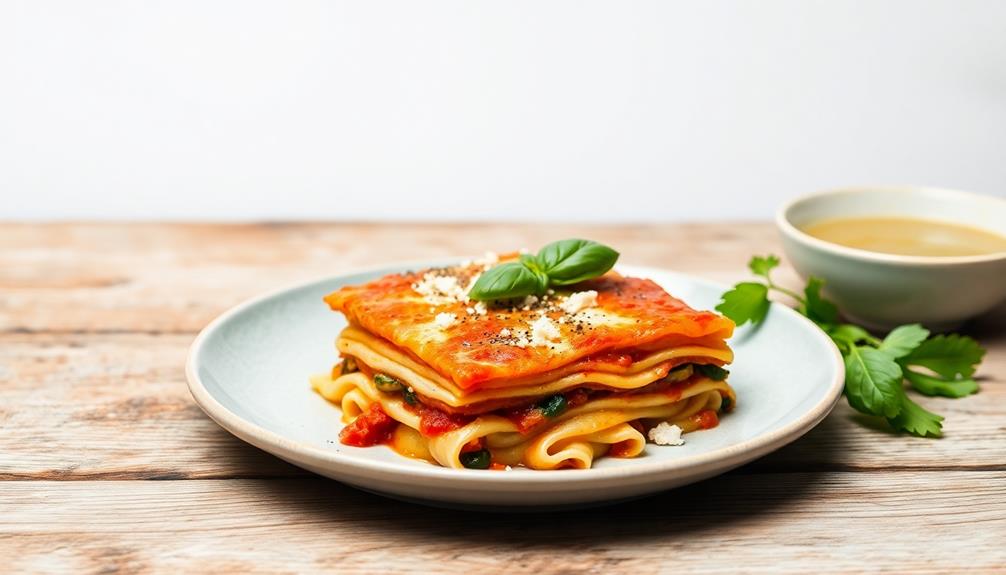Vegan baking opens up a world of creative possibilities, with a range of egg and dairy replacements that deliver rich, moist, and indulgent cakes, cookies, and treats. You can use ground flax or chia seeds to mimic eggs, while plant-based milks and yogurts lend the perfect texture and flavor. Explore the versatility of ingredients like vegan chocolate chips, applesauce, and natural sweeteners to craft irresistible baked goods. With a little practice and an open mind, you'll soon be whipping up delectable vegan creations that will delight your taste buds – and you'll be amazed at what you can achieve without eggs or dairy.
Key Takeaways
- Flax or chia seeds mixed with water can effectively replace eggs in vegan baking, providing binding and moisture to cakes and cookies.
- Plant-based milks like almond, soy, or oat milk serve as dairy alternatives to achieve the desired consistency and flavor in vegan recipes.
- Vegan butter or coconut oil can replace traditional dairy-based fats, contributing to the texture and richness of baked goods.
- Applesauce, mashed bananas, or aquafaba (chickpea liquid) can be used to add moisture and replace eggs in vegan cakes and cookies.
- Vegan chocolate chips, dried fruit, and nuts offer a range of flavors and textures to enhance the appeal of dairy-free and egg-free baked treats.
History
Tracing the origins of vegan baking, the movement can be traced back to the early 20th century.
As people became more conscious of animal rights and the environmental impact of food production, the demand for plant-based alternatives grew. Early pioneers of vegan baking experimented with ingredients like soy milk, applesauce, and ground flax seeds to replace eggs and dairy in traditional recipes.
Over time, the vegan baking community expanded, sharing techniques and recipes that showcased the versatility of dairy-free and egg-free baking. From classic cakes and cookies to innovative pastries, vegan bakers have continuously pushed the boundaries of what's possible without relying on animal-derived ingredients. Today, there are countless resources available for aspiring vegan bakers, including cookbooks, blogs, and social media groups dedicated to sharing dairy-free and egg-free recipes. In addition to sweet treats, vegan bakers have also developed savory options, such as dairyfree pizza recipes, using creative substitutions to achieve the same delicious results without sacrificing taste or texture. This growing community has proven that vegan baking is not only possible but can be just as satisfying and delicious as traditional baking. One popular technique used by vegan bakers is the use of dairyfree pizza crust recipe, which allows for a crispy and flavorful base without the need for cheese. This innovative approach has not only attracted those with dietary restrictions, but also individuals looking to explore new flavors and textures in their baking. As the demand for dairy-free and egg-free options continues to grow, the vegan baking community will no doubt continue to thrive and inspire others to explore the endless possibilities of plant-based baking.
Today, vegan baking has gained mainstream popularity, with a wealth of resources and ingredient options available to help home bakers create delicious, animal-friendly treats.
Recipe
Vegan baking can be a delightful and rewarding experience, offering an opportunity to explore creative and compassionate alternatives to traditional ingredients. The versatility of plant-based baking allows for various flavor profiles, including the soothing notes found in herbal tea, which can complement desserts beautifully.
Whether you're a seasoned vegan baker or just starting to experiment, understanding the role of egg and dairy replacements is key to achieving delicious and satisfying results.
In this recipe, we'll showcase a versatile and flavorful vegan cookie that can satisfy any sweet tooth while respecting dietary preferences and animal welfare concerns. By utilizing a carefully selected blend of plant-based ingredients, you'll be able to create a treat that's both indulgent and guilt-free.
- 2 cups all-purpose flour
- 1 teaspoon baking soda
- 1/2 teaspoon salt
- 1 cup vegan butter, softened
- 1 cup granulated sugar
- 1 tablespoon ground flax or chia seeds mixed with 3 tablespoons water
- 1 teaspoon vanilla extract
- 1 cup vegan chocolate chips
Preheat your oven to 375°F (190°C). Line a baking sheet with parchment paper or a silicone baking mat.
In a large mixing bowl, cream the vegan butter and sugar together until light and fluffy. In a separate small bowl, combine the ground flax or chia seeds with the water and let it sit for a few minutes to thicken, creating a "flax egg" or "chia egg." Add the flax or chia egg and vanilla extract to the butter-sugar mixture and mix well.
In a separate bowl, whisk together the flour, baking soda, and salt. Gradually add the dry ingredients to the wet ingredients, mixing just until combined. Fold in the vegan chocolate chips.
Scoop the dough by rounded tablespoons onto the prepared baking sheet, spacing them about 2 inches apart. Bake for 10-12 minutes, or until the edges are golden brown and the centers are still slightly soft. Allow the cookies to cool on the baking sheet for a few minutes before transferring them to a wire rack to cool completely.
Cooking Steps
Preheat your oven to 350°F.
Cream the vegan butter and sugar together until light and fluffy.
Add the dry ingredients, then the plant-based milk, gently folding in the chocolate chips last.
Step 1. Preheat Oven to 350°F
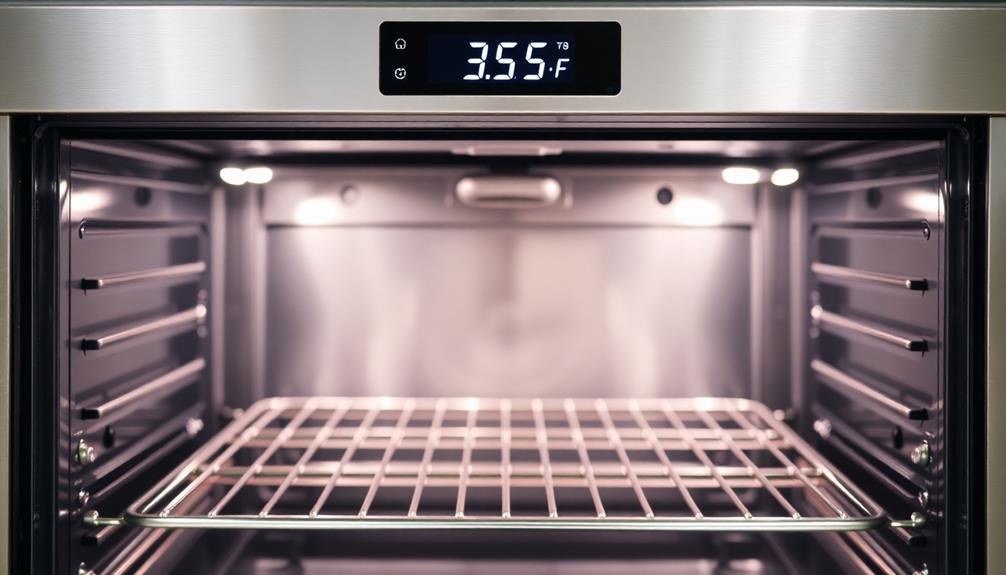
The first step in the baking process is to preheat your oven to 350°F. This crucial step ensures your oven is at the perfect temperature before you place your delicious vegan baked goods inside.
Preheating the oven takes just a few minutes, but it makes a big difference in the final outcome of your recipe.
Once you've set your oven to the right temperature, you'll want to wait until the indicator light turns off, signaling that the oven has reached 350°F. This helps guarantee even baking and prevents your baked goods from burning on the outside while remaining raw on the inside.
Properly preheating your oven is an essential part of vegan baking. It sets the stage for the rest of the cooking process, allowing your egg and dairy replacements to perform their magic and create moist, fluffy, and flavorful vegan cakes, cookies, and more.
With your oven preheated and ready to go, you can confidently move on to the next step in your vegan baking adventure.
Step 2. Cream Vegan Butter and Sugar Together

Next, cream the vegan butter and sugar together. This is a crucial step in many vegan baking recipes, as it helps create the light, fluffy texture you want in cakes and cookies.
Start by placing the vegan butter in a large bowl. Using a hand mixer or a stand mixer fitted with the paddle attachment, beat the butter on medium speed until it's nice and smooth, about 2-3 minutes.
Now, it's time to add the sugar. Gradually pour in the sugar while continuing to mix on medium speed. Scrape down the sides of the bowl as needed to ensure everything gets evenly incorporated.
Keep mixing until the butter and sugar are well combined and the mixture looks light and creamy, about 5 minutes total.
Be patient and don't rush this step – properly creaming the vegan butter and sugar is key to achieving the desired texture in your final baked goods.
Once you've got that down, you're ready to move on to the next steps in your vegan baking recipe.
Step 3. Add Dry Ingredients
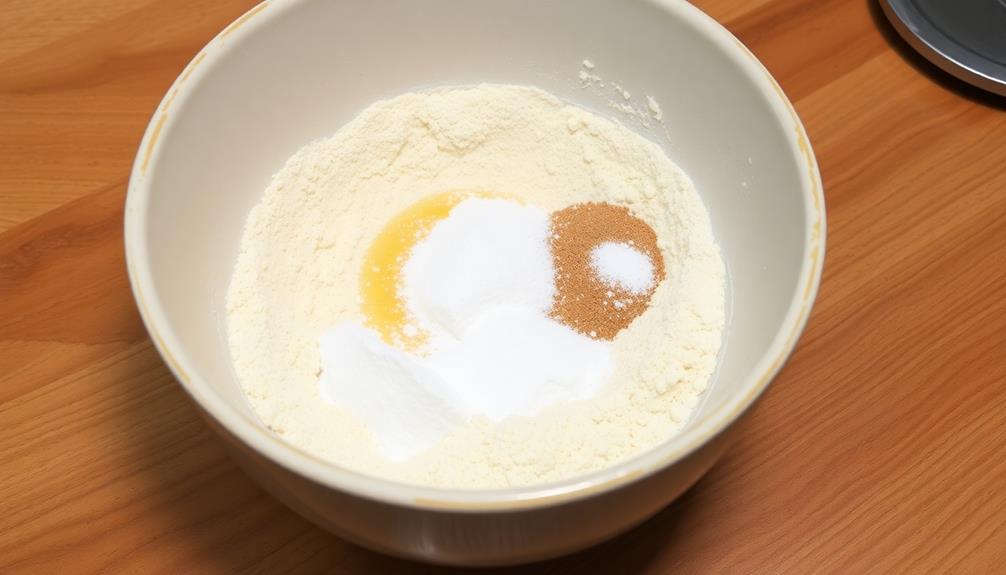
With the vegan butter and sugar now creamy and light, you can move on to incorporating the dry ingredients. First, in a separate bowl, whisk together the all-purpose flour, baking soda, and a pinch of salt. This ensures the leavening agent and seasoning are evenly distributed before adding them to the wet mixture.
Additionally, consider using natural sweeteners or adding ingredients rich in antioxidants, such as beetroot powder, for added health benefits nutritional benefits.
Next, gradually add the dry ingredients to the creamed butter and sugar, mixing on low speed until just combined. Be careful not to overmix, as this can toughen the batter.
Gently fold in any additional mix-ins, like chocolate chips or nuts, until they're evenly dispersed throughout the dough.
The key is to work the dry and wet ingredients together delicately, blending them just until no dry pockets remain. This creates a soft, tender texture in your vegan baked goods.
With the foundations laid, you're ready to portion out the dough and bake your scrumptious vegan treats!
Step 4. Add Plant-Based Milk
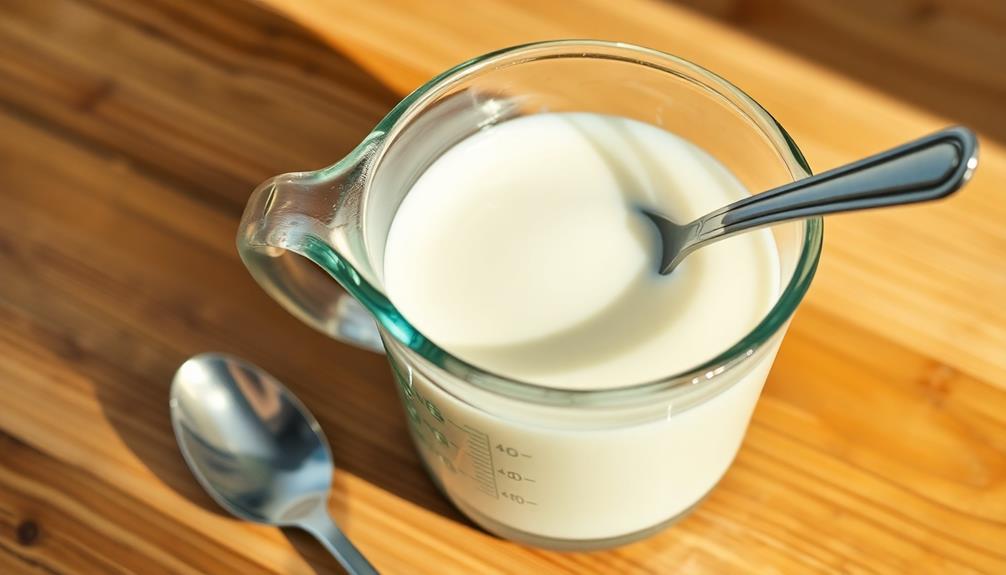
After blending the dry and wet ingredients, you'll need to add a plant-based milk to the mixture. This will help bring the batter together and create a smooth, creamy texture.
You can use any type of plant-based milk, such as almond, soy, or oat milk. Start by adding just a few tablespoons and mix well. If the batter seems too thick, add a little more milk until you reach the desired consistency.
Be careful not to overmix, as this can make your baked goods tough. The amount of plant-based milk you'll need can vary depending on the recipe, so it's best to add it slowly and check the texture as you go.
Once the batter is just right, you're ready to pour it into your prepared pan and bake. This simple step will help ensure your vegan baked goods turn out moist, tender, and delicious every time.
Step 5. Gently Fold in Chocolate Chips
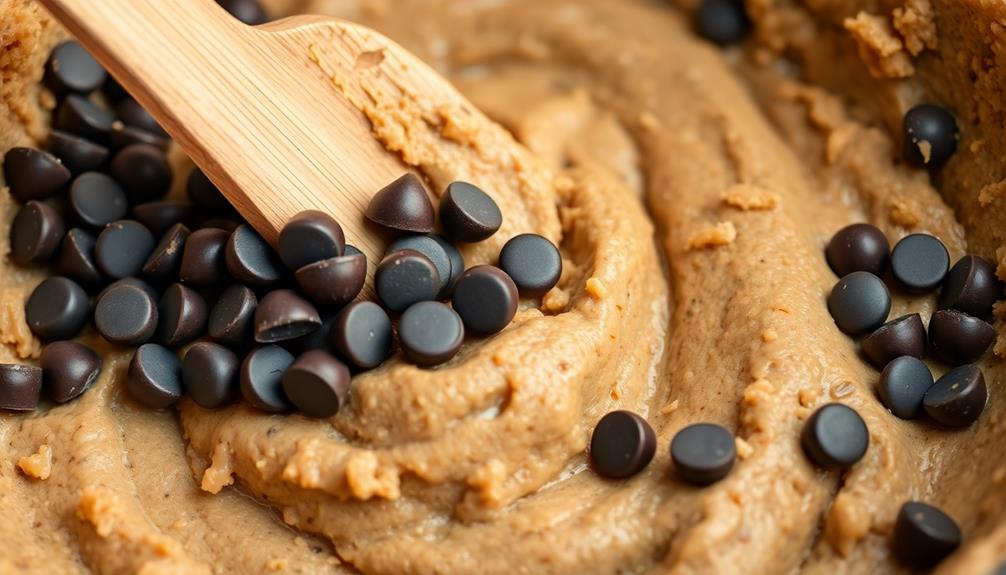
Chocolate chips are the perfect addition to many vegan baked goods, adding pockets of sweetness and texture. When it's time to incorporate them, be sure to do so gently. Use a rubber spatula to carefully fold the chocolate chips into your batter, making sure not to overmix. This will prevent the chips from breaking down and ensure they remain intact throughout your baked treats.
Folding is a gentle, circular motion that incorporates ingredients without deflating your batter. Start by scraping the bottom of the bowl to bring up any hidden chips or batter. Then, slowly sweep the spatula around the edge of the bowl, folding the batter over itself.
Repeat this process, rotating the bowl as you go, until the chocolate chips are evenly distributed. Take your time and be mindful not to stir too vigorously, as this can lead to tough, dense baked goods. With a delicate touch, you'll end up with perfectly fudgy, chocolate-studded vegan cookies or cakes.
Final Thoughts
Ultimately, vegan baking may take some initial adjustments, but the rewards of creating delicious, cruelty-free treats are well worth the effort.
By incorporating techniques such as natural farming methods to enhance your ingredients, you can elevate the quality of your baked goods.
With a little practice and creativity, you'll be whipping up vegan cakes, cookies, and other baked goods that are just as tasty as their traditional counterparts.
Don't be afraid to experiment with different egg and dairy replacements to find what works best for your recipes.
Remember that the key is to have fun and not get discouraged.
Vegan baking is a journey, and each new recipe is an opportunity to learn and grow.
So keep an open mind, embrace the challenges, and enjoy the process of creating something truly special.
Who knows, you might just surprise yourself with how amazing your vegan baked goods can be.
The possibilities are endless, so get baking and savor the sweet satisfaction of your delectable vegan creations.
Frequently Asked Questions
How Do I Store Vegan Baked Goods?
To store your vegan baked goods, keep them in an airtight container at room temperature for up to 3 days. For longer storage, freeze them in an airtight container or zip-top bag for up to 2 months.
Are Vegan Flours More Expensive Than Regular Flour?
Generally, vegan flours can be more expensive than regular flour. The higher cost is often due to the specialized ingredients and production methods required to create plant-based alternatives. However, prices may vary depending on the specific type of vegan flour.
Can I Use the Same Baking Tools for Vegan and Non-Vegan Recipes?
You can use the same baking tools for vegan and non-vegan recipes. The tools themselves don't care what kind of ingredients you use – they'll work just fine with either type of recipe.
How Long Do Vegan Cakes and Cookies Stay Fresh?
Vegan cakes and cookies typically stay fresh for 3-5 days when stored at room temperature. They might last a bit longer in the refrigerator, but the texture and flavor may change over time.
Do Vegan Baked Goods Require More Preparation Time?
You may find that vegan baked goods require a bit more preparation time. The substitutes for eggs and dairy can take a bit more work to incorporate properly, but the results are worth the extra effort.
